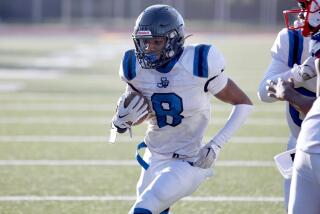Sports Talk : Franklin High’s Loss Is ELAC’s Gain
- Share via
What began as casual talks between two coaches culminated in a serious blow to the Franklin High School football program--and a shot in the arm for the one at East Los Angeles College.
Armando Gonzalez, the architect of Franklin’s immensely successful teams for the past eight seasons, has joined the ELAC staff as offensive coordinator. Several of his assistant coaches also made the move.
Under Gonzalez, Franklin won four 3-A City titles, including last year’s championship. He remains a teacher at the Highland Park high school, awaiting a similar position at ELAC.
“He (Gonzalez) and I went to Mexico and gave a couple of clinics there where they play American football, so I got to know him pretty good,” explained ELAC head coach Al Padilla. “I asked him if he had thought of moving up to JC (junior college). . . . (Later) I asked him to come over, and he said OK.”
Padilla said he was looking to the future when he recruited Gonzalez.
“He would be the most deserving guy because of his track record to eventually take over my place,” Padilla commented.
The 60-year-old Padilla has been at ELAC for 20 years. The 16 years before that he split between Garfield and Roosevelt high schools, where he coached Mike Garrett, later a USC star.
His best season at ELAC came in 1974 when he guided the team to the state crown with a 38-13 victory over San Jose Community College in the Potato Bowl in Bakersfield.
The school has not reached those heights since, but Padilla said he still has a few seasons left to try and duplicate the feat.
“I like to coach and it’s still fun for me,” he noted. “When I saw that Cal State Long Beach hired (former pro football coach) George Allen, I thought there’s still hope for us old guys.”
Meanwhile, Padilla and some of his colleagues are attempting to create a Hispanic Coaches Assn. to help procure jobs for coaches and scholarships for players, among other things.
Padilla said the organization, which is in the developmental stages, would focus first on Southern California and perhaps later expand to other areas of the state and even nationally.
“We tried to do this 15 years ago but couldn’t get it off the ground,” he noted.
Call-Waiting: After enjoying a near-perfect season at UCLA two years ago, place kicker Alfredo Velasco’s seemingly solid stock plummeted with every game played last year.
In 1988, Velasco had established a school single-season mark by converting on 89.5% of his field goal attempts (17 out of 19) and all 43 points after touchdown, and this had fueled his expectations of ascending to the professional ranks. But his performance in 1989, when he made 14 of 22 field goal tries, apparently discouraged National Football League teams, which bypassed him on draft day.
“I had my first kick blocked at San Diego State and I had never had a kick blocked before (in college). I just had a bad start and that took its toll mentally,” Velasco said.
Velasco said he still expected to be drafted but the phone never rang. He later had unsuccessful tryouts as a free agent with Green Bay, Seattle, the Rams and the Raiders, and his agent even suggested he play in Canada, but he balked at the idea.
“I want to play in the NFL. . . . Unfortunately, the teams have cut down from 120 to 80 players,” said Velasco, whose 267 points is the second highest total in UCLA history. “I’m keeping my fingers crossed. I’m confident that sooner or later something will happen.”
Montoya a Raider: Max Montoya is home again.
The former UCLA standout, 34, is now a member of the Raiders at offensive guard, the position at which he made the Pro Bowl three times in his 11 years with the Cincinnati Bengals.
The Bengals left Montoya unprotected as a Plan B free agent after last season and that was exactly the opening Raider owner Al Davis needed to sign the 6-foot, 5-inch, 285-pound star. The main enticement was a reported $1.45-million contract for two years.
“(It) was one of my dreams to end up playing out here in L.A.,” Montoya, who grew up in Montebello, told an interviewer. “This is where I started and I’d like to end it here.”
More to Read
Get our high school sports newsletter
Prep Rally is devoted to the SoCal high school sports experience, bringing you scores, stories and a behind-the-scenes look at what makes prep sports so popular.
You may occasionally receive promotional content from the Los Angeles Times.






